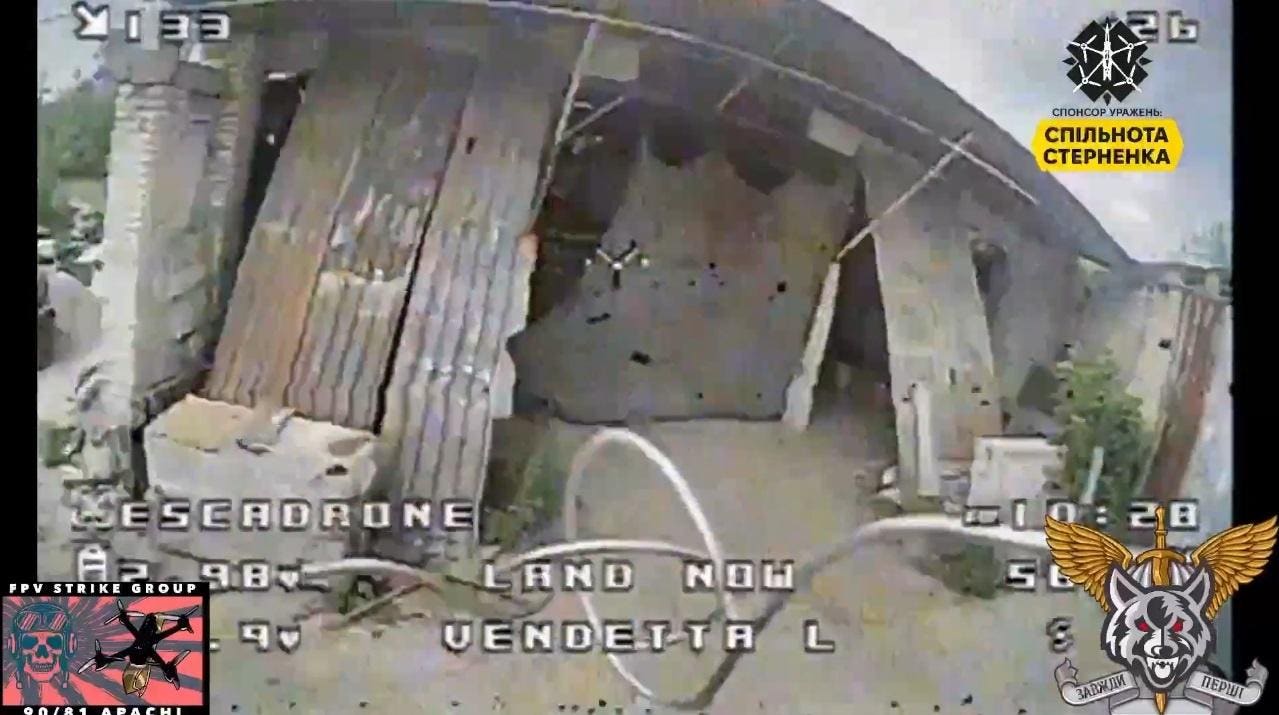A video posted on social media this week shows an unusual duel between Ukrainian drones and a Russian mobile air defence system. It might be more accurate to describe it as high-stakes hide-and-seek as a series of drones sought out the system’s hiding place and systematically blasted a way into it.
The video, posted by drone fundraiser Serhii Sternenko, tells us a lot about drone warfare and air defense today.
Gecko AKA Wasp
To NATO it is the Sa-8 “Gecko”, but the Russians call it 9K33 Osa (“Wasp”), a 17-ton, 30-foot vehicle with a six-wheeled body, carrying a complete self-contained air defense system with search and tracking radar and six missiles ready to fire. It has a crew of five — commander and driver in the cab up front, three radar and missile operators behind.
The Osa provides protection from aerial threats for Russian armored units on the move. It usually fires two radar-guided missiles together, each with a claimed 55%-85% chance of scoring a kill, so a salvo of two should bring down a target. The system has been upgraded several times since its introduction in the 1970s and the current missile has an effective range of more than 7 miles.
While most Russian air defence systems have struggled to detect and shoot down small drones due to design flaws, the Osa appears to be one of the better ones. Russian media claim it has destroyed “several hundred air targets” in the current conflict.
Even the Ukrainians acknowledge that Osa is a threat to both medium-range reconnaissance drones like the Fury and Leleka as well as well as Baba Yaga heavy bombers. This capability, plus its price tag, variously quoted at $4m-$10m, make the Osa a high value target.
Locate And Destroy
The Osa is initially seen on a the road. Moving vehicles near the front line are quickly spotted by the ubiquitous drones, but the Osa needs to be close to the front to engage Ukrainian drones.
There is no indication that the Russians knew they had been seen, and they do not attempt to shoot down the reconnaissance drone. But in the next scene (at the 0:18 mark) the Osa is seen parking in what looks like a truck garage.
The FPV drone operators of the 90th Airmobile Battalion, who use the name “90/81 Apachi,” are soon after it. Sternenko states that they are flying ‘very heavy’ drones.
Early FPV drones had a payload of around 3 pounds, usually a repurposed RPG warhead. Since then larger versions have become more common and heavy and very heavy versions can carry two or three times as much, or more (there is a tradeoff between payload and range). The latest Queen Hornet FPV can carry a 15-pound warhead.
At the :28 mark the first FPV flies into the garage, and we see a metal door blocking the way. The operator does not look for a way through but simply flies right into it. The view from the observation drone shows a small orange flash, but this is not followed by the clouds of smoke that would indicate real damage.
At 0:36 a second FPV follows the same path as the first. In the last moment before impact the operator sees the way is still mainly blocked but the door is showing signs of damage and they steers around to a gap on the left. This time the effect of the hit is not seen.
At 0:52 the third drone comes in. This time the garage door is in pieces and the drone flies all the way into the garage.
At 0:58 the garage is smoking. Four men come out, then a fifth emerges from the smoke as orange flame starts to lick from the open garage. That accounts for the entire crew, who were presumably inside the vehicle and avoided injury. They hurry away from the fire but remain in the area.
The video goes on to show clouds of thick black smoke billowing from the garage above bright flames, indicating that fire has taken hold.
Strike one multimillion dollar Osa mobile air defence system, a loss duly recorded by OSINT analysts at Oryx who diligently confirm Russian losses.
We Can Hit It Even If It Is Hidden
This is not the first time the Ukrainians have flown FPVs inside buildings to destroy Russian vehicles. David Axe described an attack in February in which the kamikazes successively blew up several Russian tanks sheltering inside a warehouse. After two years of operations, pilots have honed their skills to a fine edge. What is interesting here is the use of repeated strikes to blast through the protective cover.
This time the obstacle was a metal door. O other occasions Ukrainian FPVs have blown holes in roofs to get to a target. Even a brick wall can only withstand so many hit, and FPVs are abundant enough that they can keep hitting a target until they get through; this T-90M was hit seven times in succession before it succumbed. At around $500 a time, it’s still a cheap kill.
These drones are bringing a new type of agile, low-cost precision to the battlefield. It is not just a question of hitting the right building: the drones can fly around and strike the right part of the right door from the right direction. It is a capability that simply did not exist before for portable infantry weapons.
Behind the scene there was close co-operation with reconnaissance assets. Ukraine’s efficient battlespace awareness management system ensures that all data, for example the location of vehicle spotted by a surveillance drone, is immediately available so precisely-located targets can be engaged at once.
The attack drones also give close-up battle damage assessment, as each one records the effects of previous hits. And the whole action is recorded from long range by a larger drone with a powerful zoom lens.
On the Russian side it is interesting what is missing. The Osa is a high-value, soft-skinned vehicle. Any piece of flying shrapnel could damage and antenna and put the whole system. You might have expected such an important asset to be protected from drones by the best electronic jamming available. So either the Russians did not supply the Osa with a jammer (perhaps due to issues with interference)…or they had a jammer which simply did not work. Maybe that metal garage door was a factor.
The Russians certainly know about the threat from FPVs. There was a similar engagement back in March when a Russian Osa hiding in barn was targeted by an FPV drone from the Asgard unit. The Russians may have learned that simply hiding is not enough, and that they need to put solid protection between themselves and the attack drones. But the latest encounter shows that they need something more solid to hide behind.
If that Osa crew ever get another vehicle, they may want to park it inside a bunker.
Read the full article here





